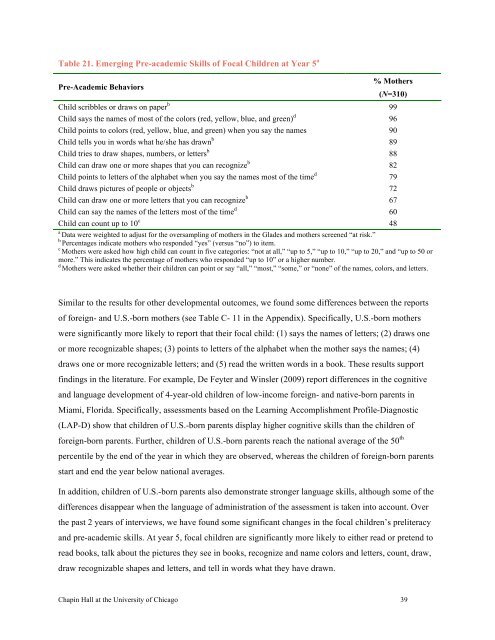2011 The Palm Beach County Family Study (Full Report)
2011 The Palm Beach County Family Study (Full Report)
2011 The Palm Beach County Family Study (Full Report)
- No tags were found...
Create successful ePaper yourself
Turn your PDF publications into a flip-book with our unique Google optimized e-Paper software.
Table 21. Emerging Pre-academic Skills of Focal Children at Year 5 aPre-Academic Behaviors% Mothers(N=310)Child scribbles or draws on paper b 99Child says the names of most of the colors (red, yellow, blue, and green) d 96Child points to colors (red, yellow, blue, and green) when you say the names 90Child tells you in words what he/she has drawn b 89Child tries to draw shapes, numbers, or letters b 88Child can draw one or more shapes that you can recognize b 82Child points to letters of the alphabet when you say the names most of the time d 79Child draws pictures of people or objects b 72Child can draw one or more letters that you can recognize b 67Child can say the names of the letters most of the time d 60Child can count up to 10 c 48aData were weighted to adjust for the oversampling of mothers in the Glades and mothers screened “at risk.”bPercentages indicate mothers who responded “yes” (versus “no”) to item.cMothers were asked how high child can count in five categories: “not at all,” “up to 5,” “up to 10,” “up to 20,” and “up to 50 ormore.” This indicates the percentage of mothers who responded “up to 10” or a higher number.dMothers were asked whether their children can point or say “all,” “most,” “some,” or “none” of the names, colors, and letters.Similar to the results for other developmental outcomes, we found some differences between the reportsof foreign- and U.S.-born mothers (see Table C- 11 in the Appendix). Specifically, U.S.-born motherswere significantly more likely to report that their focal child: (1) says the names of letters; (2) draws oneor more recognizable shapes; (3) points to letters of the alphabet when the mother says the names; (4)draws one or more recognizable letters; and (5) read the written words in a book. <strong>The</strong>se results supportfindings in the literature. For example, De Feyter and Winsler (2009) report differences in the cognitiveand language development of 4-year-old children of low-income foreign- and native-born parents inMiami, Florida. Specifically, assessments based on the Learning Accomplishment Profile-Diagnostic(LAP-D) show that children of U.S.-born parents display higher cognitive skills than the children offoreign-born parents. Further, children of U.S.-born parents reach the national average of the 50 thpercentile by the end of the year in which they are observed, whereas the children of foreign-born parentsstart and end the year below national averages.In addition, children of U.S.-born parents also demonstrate stronger language skills, although some of thedifferences disappear when the language of administration of the assessment is taken into account. Overthe past 2 years of interviews, we have found some significant changes in the focal children’s preliteracyand pre-academic skills. At year 5, focal children are significantly more likely to either read or pretend toread books, talk about the pictures they see in books, recognize and name colors and letters, count, draw,draw recognizable shapes and letters, and tell in words what they have drawn.Chapin Hall at the University of Chicago 39
















